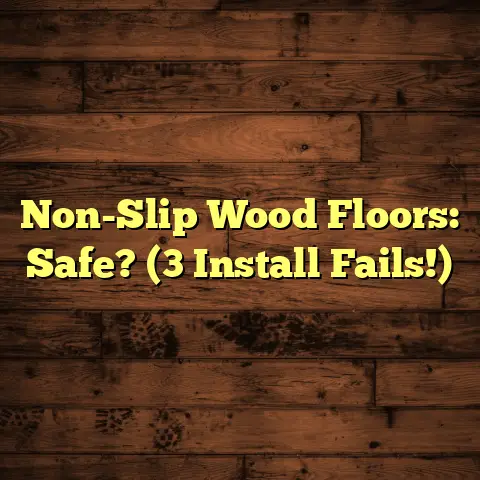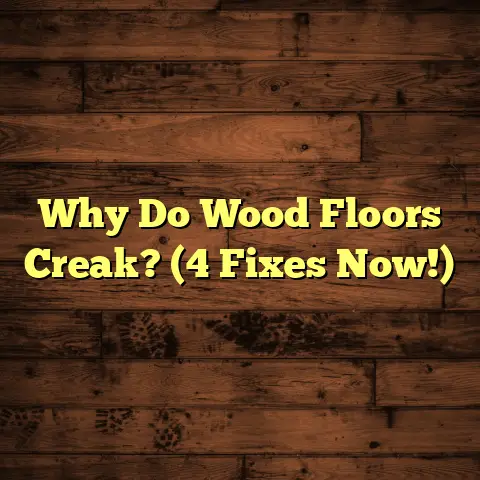Buffing Hardwood Floors: Yes or No? (1 Pro Tip)
One of the most common questions I get asked is: “Should I buff my hardwood floors?”
Hardwood floors, right? They’re like the little black dress of home design – classic, elegant, and always in style.
They bring warmth, character, and a touch of luxury to any space. But let’s be real: keeping them looking their best takes work.
We’re talking about sweeping, mopping, and the occasional existential crisis when you spot a new scratch.
That’s where the idea of buffing comes in. It sounds simple enough, right? A quick once-over with a machine and poof, your floors are gleaming again?
But is it really that straightforward? Is buffing always the answer, or could it actually do more harm than good?
That’s what we’re diving into today. Think of me as your friendly neighborhood flooring guru, here to help you navigate the sometimes-confusing world of hardwood floor maintenance.
We’ll explore whether buffing is a necessary step in maintaining your hardwood floors. So, grab a cup of coffee, kick back, and let’s get started.
Section 1: Room-Specific Needs
Okay, let’s talk rooms. Not all rooms are created equal, especially when it comes to hardwood floor maintenance.
What works for the bedroom might be a disaster in the kitchen. It really boils down to how you use each space.
1. Living Room
Ah, the living room – the heart of the home. It’s where we gather with family, entertain friends, and binge-watch our favorite shows.
It also means lots of foot traffic. All that walking, running, and maybe even the occasional dance party can take a toll on your floors.
Aesthetics are super important here, right? You want your living room to look inviting and well-maintained.
Buffing can be a great way to enhance the room’s overall appearance. It can restore some of the shine that gets lost over time and help minimize the appearance of minor scratches.
The type of finish you have in your living room will also play a role. For example, polyurethane finishes are pretty durable and can usually handle buffing without any issues.
However, if you have a more delicate finish, like shellac, you might want to think twice before grabbing the buffer.
2. Kitchen
Now, the kitchen – a whole different ballgame. Spills, stains, food particles… It’s a battlefield out there!
The kitchen presents unique challenges for hardwood floors. Moisture is the enemy, and let’s face it, kitchens are moisture magnets.
So, can buffing help maintain the wood’s integrity and appearance in the kitchen? It’s a tricky question.
On one hand, buffing can help remove some surface-level dirt and grime. On the other hand, if you’re dealing with moisture damage, buffing isn’t going to solve the problem.
In fact, it could actually make things worse by grinding the moisture further into the wood.
If you’re considering buffing your kitchen floors, be extra careful about the type of finish you have and the overall condition of the wood.
You might want to consider a more water-resistant flooring option for the kitchen altogether.
3. Bedroom
The bedroom – your sanctuary, your escape from the chaos of daily life. It’s usually a quieter, less-trafficked space compared to the living room or kitchen.
So, is buffing even necessary here? Maybe not as frequently. Dust and allergens can definitely accumulate in bedrooms, and regular cleaning is a must.
But buffing might not be the most effective way to tackle those issues. A good vacuum and a damp mop can often do the trick.
Of course, if you notice that your bedroom floors are looking particularly dull or scratched, buffing could help restore some of their luster.
But again, it depends on the type of finish you have and the overall condition of the wood.
4. Hallways and Entryways
Hallways and entryways – the high-traffic zones of your home. These areas see a lot of action, and they’re often the first place people see when they walk in the door.
Wear and tear is inevitable. All that foot traffic can lead to scratches, scuffs, and a general dulling of the finish.
Buffing might be beneficial in these areas, as it can help minimize the appearance of surface scratches and restore some of the shine.
But you need to be careful not to overdo it. Buffing too frequently can actually wear down the finish and damage the wood over time.
Consider using rugs or mats in high-traffic areas to help protect your floors and reduce the need for frequent buffing.
5. Basements and Utility Rooms
Basements and utility rooms – often overlooked when it comes to flooring, but they definitely deserve some attention.
Humidity and temperature variations can wreak havoc on hardwood floors in these spaces. Moisture is a major concern.
So, is buffing a practical option in basements and utility rooms? Honestly, probably not.
If you’re dealing with moisture issues, buffing is not the answer. You need to address the underlying problem first.
In fact, buffing could actually make things worse by trapping moisture and promoting mold growth.
I generally advise against installing hardwood floors in basements or utility rooms, unless you have a very well- ventilated and climate-controlled space.
Section 2: The Pros and Cons of Buffing
Alright, let’s get down to the nitty-gritty: the pros and cons of buffing hardwood floors.
Like anything else in life, there are benefits and drawbacks to consider. It’s all about weighing the options and deciding what’s best for your floors.
Pros
-
Restore Shine: This is probably the biggest reason people consider buffing. Over time, hardwood floors can lose their luster and start to look dull.
Buffing can help bring back that shine by removing surface dirt and grime and smoothing out minor imperfections. It’s like giving your floors a mini-makeover.
-
Mask Minor Scratches: Let’s be honest, scratches are inevitable. Whether it’s from pets, furniture, or just general wear and tear, they’re going to happen.
Buffing can help minimize the appearance of surface scratches by blending them in with the surrounding finish. It won’t completely eliminate them, but it can definitely make them less noticeable.
-
Extend the Life of the Finish: This is where buffing can really shine (pun intended!). By maintaining the protective layer on the wood, you’re prolonging its life.
Think of it like waxing your car – it helps protect the paint from the elements and keeps it looking newer for longer. Buffing can do the same for your hardwood floors.
Cons
-
Not Suitable for All Finishes: This is a huge one. Certain finishes, like oil-based or older finishes, may not react well to buffing.
In some cases, buffing can actually damage the finish or leave behind swirl marks. Always check with a flooring professional or the manufacturer of your finish before buffing.
-
Temporary Solution: Let’s be clear: buffing is not a substitute for refinishing. It’s a short-term fix that can help improve the appearance of your floors.
But if you have deep scratches, significant damage, or a finish that’s completely worn down, refinishing is the only way to truly restore your floors.
-
Potential Damage: This is where things can get dicey. If done incorrectly or too frequently, buffing can actually damage the wood.
Using the wrong type of buffing pad, applying too much pressure, or buffing against the grain can all lead to problems. It’s really important to know what you’re doing or hire a professional.
Section 3: Expert Insight
Okay, so you’ve heard my take on buffing. But what do other experts have to say? I reached out to some flooring specialists, home improvement experts, and professional cleaners to get their opinions.
Here’s what they had to say:
-
Sarah Miller, Flooring Specialist: “Buffing can be a great way to maintain the shine of hardwood floors, but it’s not a one-size-fits-all solution. It’s important to consider the type of finish, the condition of the floors, and the frequency of foot traffic before deciding to buff.”
-
Tom Johnson, Home Improvement Expert: “I’m a big fan of buffing, but only when it’s done right. I’ve seen too many homeowners damage their floors by using the wrong equipment or technique. If you’re not comfortable doing it yourself, hire a professional.”
-
Maria Rodriguez, Professional Cleaner: “Buffing can definitely help improve the appearance of hardwood floors, but it’s not a substitute for regular cleaning. It’s important to sweep or vacuum regularly and mop up spills promptly to prevent damage.”
One thing that really stood out to me was that everyone emphasized the importance of proper technique.
Buffing might seem simple, but it’s easy to mess things up if you’re not careful.
I also found that there were some differing perspectives on whether buffing is a worthwhile investment for homeowners.
Some experts felt that it was a great way to extend the life of the finish and keep floors looking their best.
Others felt that it was unnecessary and that regular cleaning was sufficient.
Ultimately, it comes down to personal preference and the specific needs of your floors.
Section 4: The Pro Tip – When to Buff and When to Avoid It
Alright, it’s time for the pro tip! After years of working with hardwood floors, I’ve developed a pretty good sense of when buffing is appropriate and when it’s not.
Here’s my guideline, based on the most critical factors:
-
Floor Finish Type: This is the most important factor.
- Polyurethane: Generally safe to buff, but always test a small, inconspicuous area first.
- Oil-Based: Proceed with caution. Buffing can sometimes damage oil-based finishes.
- Shellac: Avoid buffing altogether. Shellac is a very delicate finish and can be easily damaged.
- Waxed: Buffing can actually help maintain a waxed finish, but use a soft buffing pad and avoid excessive pressure.
-
Condition of the Floors: Take a close look at your floors.
- Minor Scratches and Dullness: Buffing can be a great way to improve the appearance.
- Deep Scratches or Significant Damage: Buffing won’t help. You’ll need to refinish.
- Worn Finish: Buffing can help temporarily, but refinishing is the best long-term solution.
-
Frequency of Foot Traffic: Consider how much traffic your floors see.
- High-Traffic Areas: Buffing might be necessary more frequently (every 6-12 months).
- Low-Traffic Areas: Buffing might only be needed every 1-2 years, or even less.
-
Environmental Conditions: Humidity and temperature can play a role.
- High Humidity: Avoid buffing if your floors are prone to moisture damage.
- Extreme Temperature Variations: Buffing might not be the best option, as it can stress the finish.
Here’s the bottom line: If you’re unsure whether or not to buff your hardwood floors, err on the side of caution.
It’s always better to be safe than sorry. Consult with a flooring professional or test a small, inconspicuous area before buffing the entire floor.
Understanding these factors can lead to better decision- making regarding hardwood floor care.
Conclusion
So, there you have it – the lowdown on buffing hardwood floors. We’ve covered a lot of ground, from room-specific needs to the pros and cons of buffing to expert insights.
The most important takeaway is that there’s no one-size-fits- all answer. Whether or not you should buff your hardwood floors depends on a variety of factors.
You need to consider the type of finish you have, the condition of your floors, the frequency of foot traffic, and the environmental conditions in your home.
It also comes down to personal preference. Some people love the look of freshly buffed floors, while others are perfectly happy with a more natural, lived-in look.
Before deciding whether buffing is the right choice for you, take a good, hard look at your floors. Assess their condition, consider how you use the space, and think about your maintenance needs.
And if you’re ever in doubt, don’t hesitate to consult with a flooring professional. They can provide you with personalized advice and help you make the best decision for your floors.
Ultimately, the goal is to keep your hardwood floors looking their best for years to come. And with a little knowledge and care, you can definitely achieve that!





